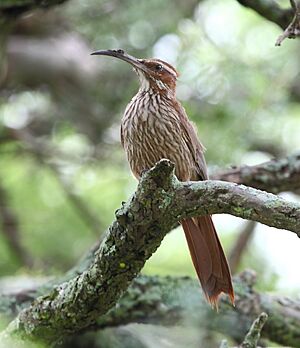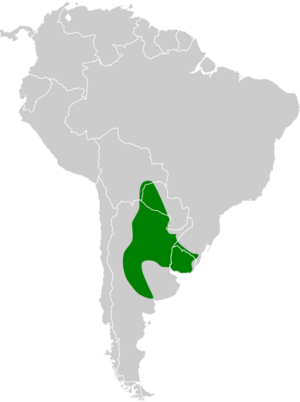Scimitar-billed woodcreeper facts for kids
Quick facts for kids Scimitar-billed woodcreeper |
|
|---|---|
 |
|
| At Santa Fe Province, Argentina | |
| Conservation status | |
| Scientific classification | |
| Genus: |
Drymornis
|
| Species: |
bridgesii
|
 |
|
The scimitar-billed woodcreeper (Drymornis bridgesii) is a unique type of bird. It belongs to the Dendrocolaptinae group, which is part of the ovenbird family called Furnariidae. You can find this bird in several South American countries. These include Argentina, Bolivia, Brazil, Paraguay, and Uruguay.
Contents
About the Scimitar-billed Woodcreeper
This bird is the only species in its entire group, or genus, called Drymornis. This means it's pretty special! It is most closely related to another bird called the greater scythebill.
What Does It Look Like?
The scimitar-billed woodcreeper is a fairly large bird. It measures about 26 to 35 cm (10 to 14 in) long. It weighs between 76 and 110 g (2.7 to 3.9 oz).
It has a short tail and a long, curved beak, which looks a bit like a scimitar sword. Both male and female birds look the same. Adults have dark reddish-brown feathers around their ears. They also have a white stripe above their eye and a white "moustache" stripe.
Their head and neck are reddish-brown to dark brown. Their back, shoulders, and most wing feathers are cinnamon-brown or reddish-brown. The feathers on their lower back and tail are a brighter reddish-brown.
Their throat is white. The rest of their underside is reddish-brown with clear white stripes. These stripes have dark brown edges. Their eyes can be yellowish, light grayish-brown, or dark brown. Their beak is brownish or black, with a pinkish bottom part. Their legs and feet are usually gray or dull black.
Young scimitar-billed woodcreepers have dark and light chestnut stripes on their neck. Their stripes on the underside are not as clear as those on adults.
Where Does It Live?
You can find the scimitar-billed woodcreeper in specific parts of South America. This includes southeastern Bolivia, western Paraguay, and the Brazilian state of Rio Grande do Sul. It also lives throughout Uruguay and south into north-central Argentina.
This bird prefers to live in certain types of environments. These include woodlands, scrublands, and thorny forests. It also lives in savannas, which are grassy areas with scattered trees. Sometimes, you can even find them in old pastures and small wooded areas near farms.
In most places, they live at elevations up to 500 meters (1,600 ft) above sea level. However, in some parts of Argentina, they can be found as high as 1,350 meters (4,430 ft).
How Does It Behave?
Daily Life and Movement
Scientists believe that the scimitar-billed woodcreeper stays in the same area all year round. This means they do not migrate long distances. However, some birds might move to different spots after the breeding season.
What Does It Eat?
This bird is quite special among woodcreepers because it mostly looks for food on the ground. But it also searches for food on trees and even cacti.
Its diet is very varied! It eats many different things, including:
- Insects and other small creatures like spiders (called arthropods).
- Other invertebrates, such as snails.
- Many kinds of small animals with backbones, like frogs, snakes, and lizards.
- Even baby birds from other nests!
- Eggs from reptiles and other birds.
The scimitar-billed woodcreeper catches its prey in different ways. It might poke its beak into the ground, into plants like bromeliads, or into holes in trees and cacti. It also simply picks up food from the ground. They usually look for food alone or in pairs. Sometimes, they are seen in small groups, even with other bird species.
Reproduction and Life Cycle
Scimitar-billed woodcreepers breed between September and December. They build their nests inside holes in trees and palm trees. These holes are usually natural, but they might also use holes made by woodpeckers. They have even been seen using old nests built by the rufous hornero bird.
They line the bottom of their nest with leaves, bark, or wood chips. A female bird usually lays three eggs. The eggs hatch after about 14 days. The baby birds are ready to leave the nest about 21 days after they hatch. Both the male and female birds help build the nest, sit on the eggs, and take care of the young birds.
Bird Calls and Songs
The scimitar-billed woodcreeper has a unique song. It sounds like a series of whistled notes that go down in pitch and slow down, like "tweedle tweedle tweed twee twee". It also sings a more level series of whistled notes, like "jli jli jli jli jli".
Its calls include sounds like "sik, tsis-sik, or tsis-sik-sik". They also make a sound like "cheedle" repeated three times. Sometimes, a pair of birds will sing together in a duet!
Is It Endangered?
The IUCN (International Union for Conservation of Nature) has evaluated the scimitar-billed woodcreeper. They have listed it as a species of "Least Concern." This means it is not currently considered to be in danger of disappearing.
The bird lives across a fairly large area. Even though we don't know the exact number of birds, their population seems to be stable. There are no immediate threats that scientists have found. However, more studies are needed to understand exactly what kind of habitat this bird needs to thrive. This is because it can be sensitive to changes in its environment.


